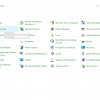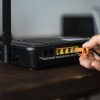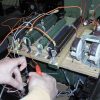Slow Laptop is tiresome to many of the users. The computer should perform in an efficient way to finish the work in stipulated time. Slow functioning of Laptop Creates a problem to the user and creates frustration while performing a task. If the laptop is too slow then check then you have to check whether there is plenty of free space on the hard drive holding your operating system. Windows needs room to create files while your system is running on the computer. If your hard drive is maxed out, performance suffers. So, It is the perfect time to clear some space.
Microsoft’s System Configuration tool is your next-best bet for tackling slow performance and boost the performance. Many applications launch automatically when your machine boots up, which can stretch out boot time especially on older and slower PCs. Open the tool by pressing Windows-R, typing msconfig, and pressing the Enter key. Checking the Startup Item and Manufacturer columns is the best way to figure out which potential performance-killers you can safely disable. Avoid messing with any of the services and programs that have Microsoft Corporation listed as the manufacturer. Here, we have listed some of the guidelines to make the computer faster:
Restart your computer:
This can temporarily method to speed up a slow computer by refreshing the memory. You can Restart, or completely shut down the computer, wait a few seconds, and then turn it back on. You need to make sure you save any projects you are working on before turning off your computer.
Back up your computer:
Many of us have what feels like our entire lives stored on our computers photos of cherished memories which can be the evolution of our musical taste, school work and everything we need to do our work. Before making any major changes, it is always a good idea to back up essential files on any drive. You can Purchase an external hard drive that is larger than the hard drive that you want to back up. Inserting the USB of the external hard drive should automatically prompt your computer to give you the option to use the drive for Back up purpose. If you are worried about losing or damaging an external hard drive, you can back up important files online also. Subscribe to a secure backup service so that the failure of the external drive may not lead to the problem. You can set your computer to back up to the cloud on a schedule or even every time or time you want to change to a file. You can always back up onto CDs or DVDs or any hard drive, but keep them in a safe place so they are not scratched, broken, or damaged.
Run a Disk Cleanup:
This can clean up hundreds of megabytes by deleting temporary files, unnecessary system files, and emptying your recycling bin on your computer. Firstly, Click My Computer, right-click Hard Drive, then click Properties then Click Disc Cleanup. A window will pop up asking which files you’d like to remove then Check those you wish to delete and run the cleanup. If you have multiple drives or a partition, you must select the one you want to be cleaned. Also, Install an anti-virus program, spyware scanner, and an anti-malware software. The fewer bugs, viruses, and bits of adware your computer has to manage so that the more time it will have to devote to other processes.
Keep Windows up-to-date:
Not only will this keep Windows itself running smoothly, but some viruses ride in on Windows updates that are downloaded long after the update is available. Change the power plan of your desktop computer to High Performance. For this, Go to the Control Panel and select Power Options. You will find a list of power plans, usually Balanced, Power Saver, and High Performance. These settings control how your computer uses power either by lowering performance to optimize battery life, maximizing performance with major power consumption, or a balance between these two. Selecting High Performance may increase the overall speed and performance of a computer. This is only helpful if you have a desktop PC that uses the High-Performance setting on a laptop that will drain your battery power.
Remove any programs you do not use:
Firstly, Go to the Control Panel after that then click Add or Remove Programs. Some things will strike you as useless immediately, in which case you can remove them right away. It may help to see how often you use the program. If you right-click one of the column titles above your program list, you should be able to add additional characteristics by which to manage your programs. Check Last Used On and a column displaying the last time you used each program will appear. This will quickly show you which programs you use frequently and the ones you haven’t used in over the years. Finally, Don’t forget to empty your recycling bin also.
Check your hard disk space :
First of all, Go to My Computer, right-click Local Drive, then click Properties. There you’ll see a pie chart of your free versus used space. If the disk is mostly full, you have to remove programs and files. If there’s still plenty of room, there may be something wrong with your operating system. As a rule, you want to keep at least 15% of the hard disk space free to keep the computer running smoothly. If you find you simply need more space, consider buying and installing a Solid State Drive (SSD) to replace your hard disk which is faster and much more secure than hard drives. Generally, Most laptops don’t have the space to add an SSD.





